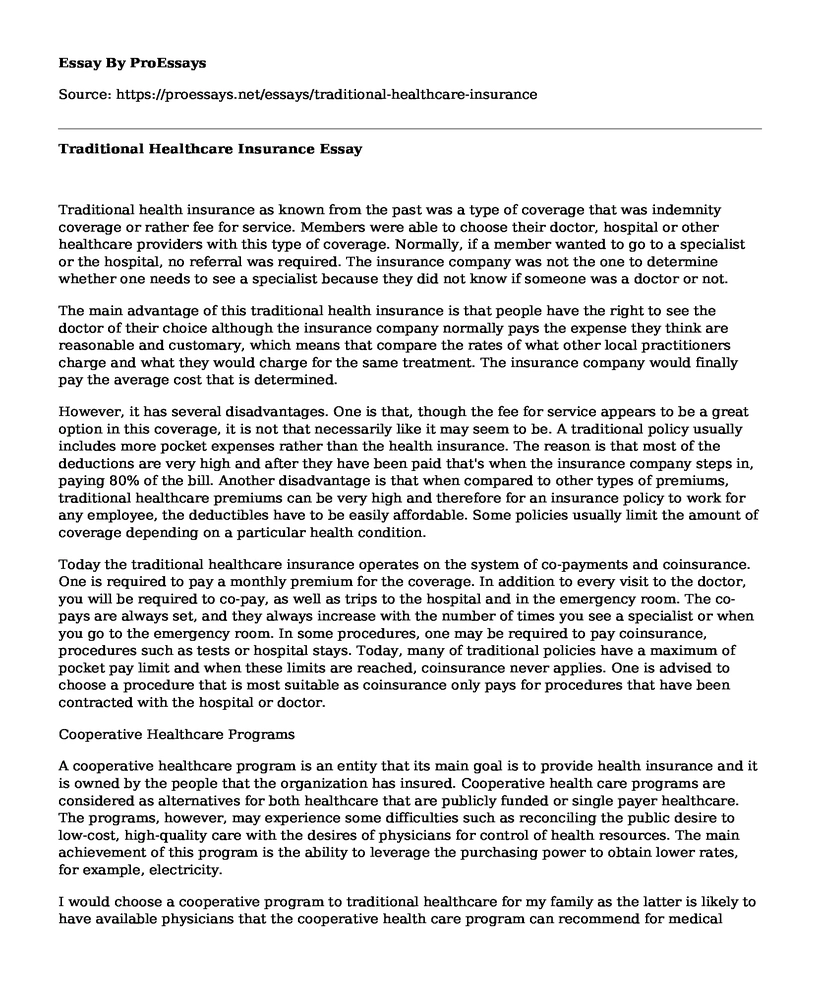Traditional health insurance as known from the past was a type of coverage that was indemnity coverage or rather fee for service. Members were able to choose their doctor, hospital or other healthcare providers with this type of coverage. Normally, if a member wanted to go to a specialist or the hospital, no referral was required. The insurance company was not the one to determine whether one needs to see a specialist because they did not know if someone was a doctor or not.
The main advantage of this traditional health insurance is that people have the right to see the doctor of their choice although the insurance company normally pays the expense they think are reasonable and customary, which means that compare the rates of what other local practitioners charge and what they would charge for the same treatment. The insurance company would finally pay the average cost that is determined.
However, it has several disadvantages. One is that, though the fee for service appears to be a great option in this coverage, it is not that necessarily like it may seem to be. A traditional policy usually includes more pocket expenses rather than the health insurance. The reason is that most of the deductions are very high and after they have been paid that's when the insurance company steps in, paying 80% of the bill. Another disadvantage is that when compared to other types of premiums, traditional healthcare premiums can be very high and therefore for an insurance policy to work for any employee, the deductibles have to be easily affordable. Some policies usually limit the amount of coverage depending on a particular health condition.
Today the traditional healthcare insurance operates on the system of co-payments and coinsurance. One is required to pay a monthly premium for the coverage. In addition to every visit to the doctor, you will be required to co-pay, as well as trips to the hospital and in the emergency room. The co-pays are always set, and they always increase with the number of times you see a specialist or when you go to the emergency room. In some procedures, one may be required to pay coinsurance, procedures such as tests or hospital stays. Today, many of traditional policies have a maximum of pocket pay limit and when these limits are reached, coinsurance never applies. One is advised to choose a procedure that is most suitable as coinsurance only pays for procedures that have been contracted with the hospital or doctor.
Cooperative Healthcare Programs
A cooperative healthcare program is an entity that its main goal is to provide health insurance and it is owned by the people that the organization has insured. Cooperative health care programs are considered as alternatives for both healthcare that are publicly funded or single payer healthcare. The programs, however, may experience some difficulties such as reconciling the public desire to low-cost, high-quality care with the desires of physicians for control of health resources. The main achievement of this program is the ability to leverage the purchasing power to obtain lower rates, for example, electricity.
I would choose a cooperative program to traditional healthcare for my family as the latter is likely to have available physicians that the cooperative health care program can recommend for medical assistance.
The Affordable Healthcare Act is likely to change a few things by improving healthcare through its mandated essential health care benefits which include:
1. Improving quality
2. Lowering health care costs
3. Strengthening Medicare
4. Holding insurance companies Accountable
Currents Articles on Healthcare
1. Putting patient record into smart cards
2. Use of hospital cards for billing purposes
3. Use of M-Health app space to give patients information and education, for example about prescriptions and pharmacy.
Cite this page
Traditional Healthcare Insurance. (2021, Mar 04). Retrieved from https://proessays.net/essays/traditional-healthcare-insurance
If you are the original author of this essay and no longer wish to have it published on the ProEssays website, please click below to request its removal:
- Case Study Example: A Social Work Student's Interview With the Client
- Social Determinants of Health in Violence Against Essay
- Ulcer Prevention in Toronto-Based Hospital in Acute Medicine Unit - Essay Sample
- Wealth Tax: Progressivity in Action in 4 European Countries - Essay Sample
- Job Satisfaction: Achieving Balance in a Multicultural Workplace - Essay Sample
- Tuberculosis: Global Concern & Its Epidemiology - Essay Sample
- Healthy People 2020: Tracking US Health Through LHIs - Essay Sample







